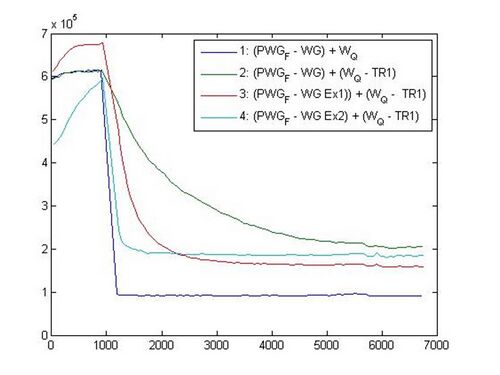Biomod/2011/Caltech/DeoxyriboNucleicAwesome/Kinetics Results
|
Monday, December 8, 2025
|
Analysis of kinetics of walking in solutionFrom gel, we obtained evidence of the walker reaching equilibrium by walking from one track to another in a solution. Next step is to analyze the kinetics of walking in a solution using SPEX. Since random walking is a reversible process, its rate constant is hard to calculate. Instead, we made an irreversible system using a walker goal. Since walker goal is very similar to the tracks except one toehold of 6nt, the kinetics of random walking in a solution can be approximated by the kinetics of walking to the walker goal.  In this experiment, a quencher is attached at the 3’ end of the walker, and a fluorophore is attached at the 5’ end of the probe for walker goal. When a walker gets to the walker goal, a fluorophore and a quencher are aligned, so the fluorescent level goes down. For the kinetics experiment, 50nM was used as 1x concentration  Above diagram shows a kinetics experiment of walker moving from the tracks to the walker goal. For sample 1 and 2, the preannealed (probe for walker goal fluorophore – walker goal) complex is mixed with the preannealed (walker quencher – track 1/2) complex. Sample 3 is a control; instead of the (walker quencher – track 1/2) complex, a free walker quencher is added to quench every fluorophore in system. Therefore sample 3 provides a maximum and minimum signal level that we can get from the system. Gradual decrease of the signal can be observed in both sample 1 and sample 2, suggesting a walker moving from track 1/2 to the walker goal. The rate constant of sample 1 and 2 should be within a range of the rate constant of 1 toehold with 6 bases, but results seem to be slow [figure 4]. Exact rate constants have not been calculated yet. The code used to fit the data and to find the rate constant will be able to be used soon. To figure out why this reaction is so slow, we tested various hypotheses.  First hypothesis is that walker goal is not completely irreversible. If there is a leak reverse reaction from the walker goal to the track, the quenching rate of quenching will be decreased. To test this hypothesis, the preannealed complex (probe for walker goal – walker goal) was mixed to a free walker making all walkers to reach the walker goal and quench the level to the minimum value. After an hour or so, track 1 or track 2 was added to each tube. If the walker goal is not irreversible, some portion of the walkers should move from the walker goal to the track, and the fluorescent level should increase. Above figure shows no noticeable increase of fluorescent level after adding tracks. Therefore, the walker goal is quite irreversible.
    Second hypothesis is the occurrence of spurious interaction between strands. Three strands were designed as shown above: track 1 without the 6 bases of poly-T at the top to avoid interaction between walker arm and poly-T part, track 1 without the probe region, and a strand that is complementary to the staple part of the probe for the walker goal to cover up the exposed staple part of the PWG_F strand. Those three stands were tested independently, but the rate does not change at all as shown in above figure, and thus, there are no apparent undesired interactions. Therefore, we still haven’t figured out why the rate of walking going to the walker goal is slower than expected. The possibility of secondary structure in ‘walker- track1’ complex was not eliminated. Another probable hypothesis might be the structural anomaly of the walker goal. In the gel, we observed that walker goal runs much slower than expected. This suggests there should be some secondary structures or dimer formation, which reduces the rate. The purpose of walker goal is to verify random walking on origami using SPEX. If getting to walker goal is harder than moving between tracks, then walker goal will not do its job effectively. Thus to make easily reachable, more irreversible walker goal, toehold of the walker goal was extended. Walker goal extended 1 has 4 more bases, and walker goal extended 2 has 8 more bases. In figure below, we can see that rate of getting to the extended walker goal is a lot faster than previous one, as expected. Thus, extended walker goal would be more effectively used than previous one in the future experiments. 
|
